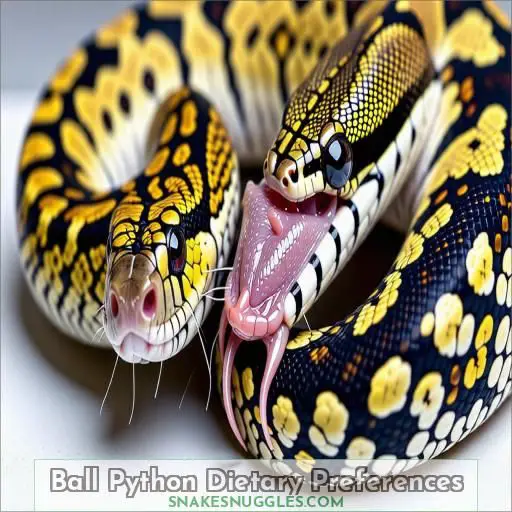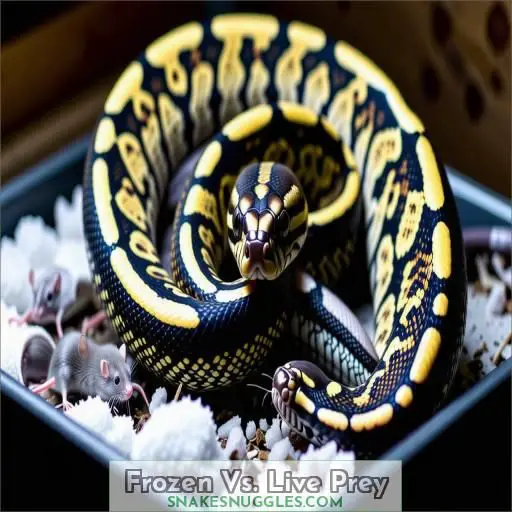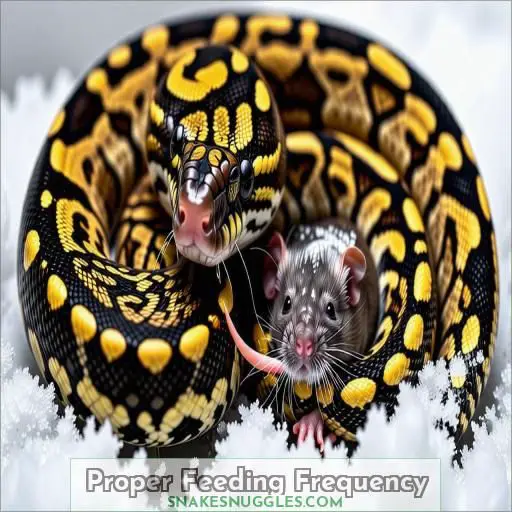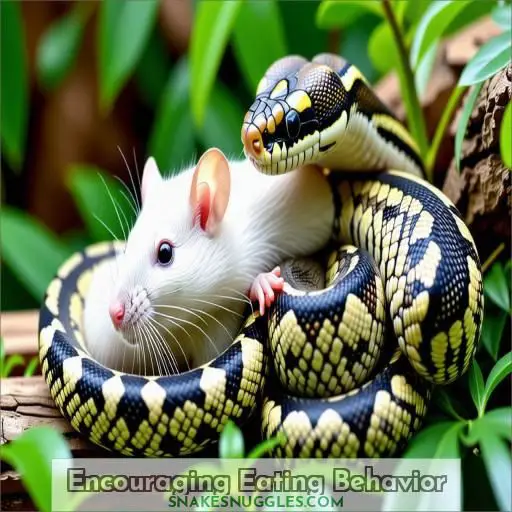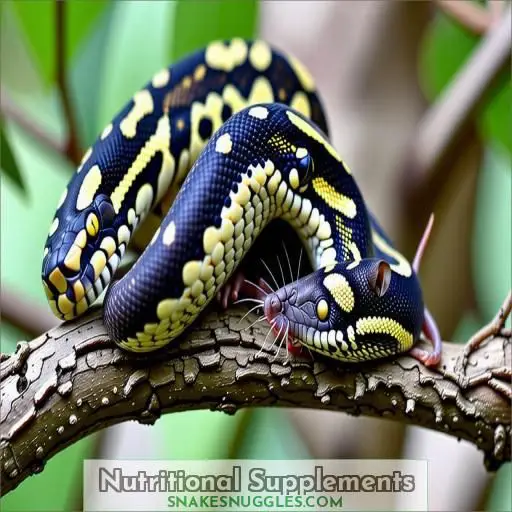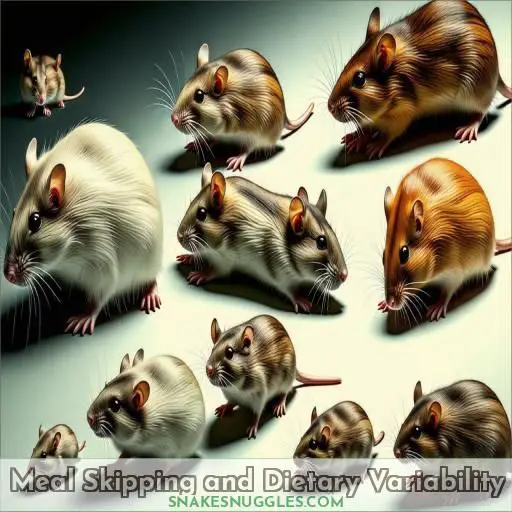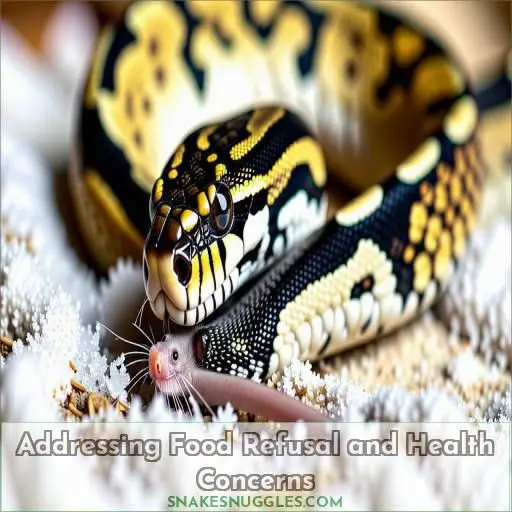This site is supported by our readers. We may earn a commission, at no cost to you, if you purchase through links.
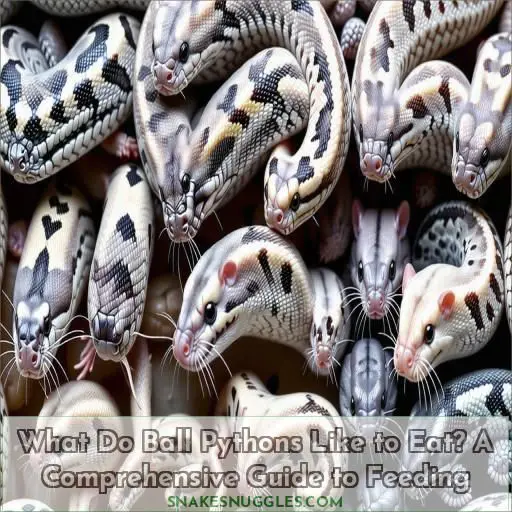 You’re in for a treat learning what ball pythons like to eat!
You’re in for a treat learning what ball pythons like to eat!
These opportunistic hunters primarily dine on rodents and small birds in the wild. With their diverse prey selection based on size, gender, and location, you’ll need to cater to your python’s specific preferences.
While frozen feeder rodents provide a convenient, risk-free option, some snakes may favor the thrill of live prey.
By understanding their dietary needs and establishing a consistent feeding routine, you can guarantee your scaly companion thrives.
But there’s more to explore in nurturing their ideal health and longevity.
Table Of Contents
- Key Takeaways
- What Do Ball Pythons Like to Eat?
- Ball Python Dietary Preferences
- Prey Selection in the Wild
- Frozen Vs. Live Prey
- Proper Feeding Frequency
- Encouraging Eating Behavior
- Nutritional Supplements
- Meal Skipping and Dietary Variability
- Addressing Food Refusal and Health Concerns
- Frequently Asked Questions (FAQs)
- What is a ball python’s favorite food?
- What can ball pythons not eat?
- How to tell if your ball python is hungry?
- Do ball pythons eat fruit?
- Can ball pythons eat insects like crickets or mealworms?
- How often do ball pythons need to eat in captivity?
- What are some signs that a ball python is overweight?
- Is it okay to feed a ball python a varied diet?
- When should I take my ball python to the vet for not eating?
- Conclusion
Key Takeaways
- Ball pythons primarily consume rodents like mice and rats, as well as small birds in the wild, with prey selection varying based on factors like location, season, and the snake’s size and gender.
- Frozen-thawed rodents are generally safer and more convenient for feeding ball pythons in captivity, eliminating the risk of injury from live prey and providing a consistent, nutritious meal.
- Proper feeding frequency is essential for maintaining optimal health, with younger or smaller snakes requiring more frequent feedings around every five days, while larger snakes can be fed once a week or every two weeks.
- Nutritional supplements, particularly calcium and vitamin D3, can be a valuable addition to a ball python’s diet, ensuring they receive all the essential vitamins and minerals they need to thrive.
What Do Ball Pythons Like to Eat?
Ball Python Dietary Preferences
- Ball pythons primarily prefer to eat small mammals such as mice and rats in captivity, which mimics their natural diet in the wild (Source).
- Their dietary preferences can be influenced by factors such as gender, size, and the availability of prey in their natural habitat (Source).
Ball Python Dietary Preferences
Ball pythons have specific dietary preferences, and comprehension of them is paramount for their well-being.
When feeding a ball python, it’s imperative to deliberate the prey size, feeding schedule, digestive enzymes, shedding schedule, and obesity prevention.
This species typically favors small frozen feeder mice or rats when young, gradually altering to larger prey as they mature .
In regard to feeding frequency, smaller and younger snakes necessitate feeding every five days, while larger ones can be fed once every week or two, with adjustments made for older snakes .
It’s essential to monitor their shedding schedule and practice caution to avert obesity .
Understanding their dietary preferences is imperative for sustaining the health and longevity of these extraordinary reptiles.
Prey Selection in the Wild
In the wild, ball pythons are opportunistic hunters that primarily consume small rodents, such as mice and rats, as well as occasional small birds. Their prey selection varies based on factors like location, prey availability, snake size, and even gender, as some differences in predation behavior exist between males and females.
Prey Selection in the Wild
In the wild, ball pythons‘ prey selection is influenced by location, season, and competition with other predators.
Their diet consists primarily of rodents and small birds, with prey size varying based on the snake’s size and gender.
Females tend to hunt smaller prey on the ground, while males may climb more to catch birds.
Prey availability is a key factor in what ball pythons eat in their natural habitat.
Rodents and Birds
In the wild, ball pythons primarily consume rodents and birds, with their exact prey varying based on local availability and abundance. Rodents like mice and rats are a staple, while birds like nestlings and immature pigeons are also commonly eaten, especially by males who tend to climb more frequently. The snakes’ size and gender influence their prey selection.
Prey Varies by Location
Ball pythons’ prey selection in the wild varies based on factors like geographical differences, seasonal changes, and prey availability.
These snakes adjust their diet preferences to match the offerings influenced by reproductive cycles and growth spurts.
Understanding how these variations impact their feeding habits is essential for providing a suitable diet in captivity, considering factors like what ball pythons like to eat and the proper feeding schedule.
Size and Gender Influence Prey
The size and gender of ball pythons greatly influence their prey selection in the wild.
Larger snakes can handle larger prey, while smaller snakes are restricted to smaller rodents and birds.
Males tend to consume more birds due to their increased climbing behavior, while females prefer mammals.
Prey availability, nutritional value, and growth patterns all play a role in shaping ball pythons’ dietary preferences for reproductive success.
Frozen Vs. Live Prey
When it comes to feeding your ball python, you have two main options: frozen or live prey.
While live prey may seem more natural, frozen-thawed rodents are generally safer and more convenient. Frozen prey eliminates the risk of injury from a live rodent and guarantees your snake receives a consistent, nutritious meal. Plus, frozen rodents are readily available and cost-effective.
Simply thaw the prey to the appropriate temperature and offer it to your ball python using tongs. Frozen-thawed prey is also easier to store and doesn’t require additional care.
However, some ball pythons may prefer live prey. If your snake refuses frozen-thawed rodents, consult with a reptile veterinarian to rule out any underlying health issues before switching to live prey.
Proper Feeding Frequency
To maintain optimal health for your ball python, it’s essential to adhere to proper feeding schedules.
Younger or smaller snakes may require more frequent feedings, around every five days, while larger snakes can be fed once a week or every two weeks.
Monitoring feeding frequency is essential to prevent obesity and address underweight snakes effectively.
Establish a consistent routine to prevent erratic feeding behaviors and promote well-being.
If your snake exhibits cage aggression, abnormal drinking patterns, or obesity concerns, reevaluate the feeding regimen promptly.
Considering vitamin supplements** for ball pythons can also aid in maintaining their health and vitality.
Encouraging Eating Behavior
To encourage your ball python’s eating behavior, you should warm frozen prey by submerging it in warm water or using a heating pad for 10-15 minutes before offering it to your snake. After your ball python has consumed its meal, promptly remove any remaining prey parts from the enclosure, thoroughly cleaning the area to maintain proper hygiene.
Warming Frozen Prey
To encourage your ball python to eat, thaw frozen prey using a water bath or microwave. Thaw for 15-30 minutes, checking frequently. Avoid leaving prey partially thawed, as this can harbor bacteria. Make sure the water bowl is clean and filled with dechlorinated water. Proper thawing and hydration promote your pet’s health and appetite.
Cleanup and Hygiene
After feeding your ball python, it’s essential to clean up properly. Dispose of any uneaten prey and wash your hands thoroughly with soap and water. Use a disinfectant cleaner to sanitize the feeding area and any equipment used. Properly dispose of waste and soiled bedding to maintain a clean, healthy environment for your pet.
- Wash hands and clean feeding area
- Disinfect equipment and enclosure
- Dispose of waste and soiled bedding
Nutritional Supplements
Nutritional supplements can be a valuable addition to your ball python’s diet, ensuring they receive all the essential vitamins and minerals they need to thrive.
Calcium and vitamin D3 are particularly important, as deficiencies can lead to metabolic bone disease.
Supplement feeder rodents by dusting them with a calcium and vitamin D3 supplement once or twice a week.
You can also offer a multivitamin supplement occasionally to provide a broader range of nutrients.
When using supplements, follow the manufacturer’s instructions carefully and avoid overuse, as excessive supplementation can be harmful.
Proper nutrition is key to maintaining your ball python’s health and longevity.
Meal Skipping and Dietary Variability
Now that you’ve mastered the basics of proper prey selection and feeding frequency, it’s important to understand that ball pythons can be quite variable in regard to their appetites. Don’t be alarmed if your snake skips a meal or two – it’s a completely normal part of their seasonal fasting behavior. In fact, it’s not uncommon for adult ball pythons to go several months without eating during the winter months.
- Seasonal fasting is a natural part of a ball python’s dietary preferences
- Your snake may refuse food due to stress, shedding, or changes in environment
- Appetite can vary based on age, size, and individual personality
- Skipping meals occasionally isn’t a cause for concern
- Offer food again in a week or two if your snake refuses
Addressing Food Refusal and Health Concerns
When addressing food refusal and health concerns in ball pythons, it’s crucial to seek veterinary consultation for expert advice.
Obtain guidance on habitat optimization, stress reduction, and parasite prevention.
If a ball python continues to refuse food, schedule a veterinary appointment.
This can help detect and address potential health issues or other factors causing the refusal.
Optimize the habitat by ensuring proper temperatures, a suitable enclosure size, and a clean environment.
This creates a stress-free space for the snake.
Offer a variety of prey types and sizes, along with warm and properly prepared meals.
This can help entice the snake to eat.
Consulting a veterinarian will provide comprehensive guidance specifically tailored to the snake’s individual needs.
This ensures its health and overall well-being.
Frequently Asked Questions (FAQs)
What is a ball python’s favorite food?
Although these reptilian rebels may seem picky, frozen-thawed rodents like rats or mice are a ball python’s favorite delicacy—providing essential nutrition for their growing bodies.
What can ball pythons not eat?
You should never feed ball pythons live rodents, as they can injure your snake. Also avoid feeding them rotten or decomposing prey, which could make them sick.
How to tell if your ball python is hungry?
Notice if your snake is prowling, periscoping, and agitated? This often indicates hunger. Healthy snakes have plump bodies. If yours is slim, feed once weekly for small snakes, biweekly for adults.
Do ball pythons eat fruit?
No, ball pythons are carnivores and don’t eat fruit. They prefer to eat rodents like mice, rats, or small birds in the wild. Provide appropriately sized frozen-thawed rodents to your pet python for a balanced diet.
Can ball pythons eat insects like crickets or mealworms?
Ironically, these carnivores aren’t fans of crickets. Ball pythons are rodent specialists, thriving on mice and rats sized appropriately for their age and build. Offering insects could risk regurgitation – a messy situation you’d want to avoid.
How often do ball pythons need to eat in captivity?
You’ll need to feed your ball python once every 5-7 days if young, every 7-10 days as an adult. Properly-sized prey is essential for their health.
What are some signs that a ball python is overweight?
You’ll know your ball python’s plump if its body seems rounded when viewed from above. Keeling ventral scales are another telltale sign — your snake’s looking a bit too well-fed.
Is it okay to feed a ball python a varied diet?
Yes, it’s fine to feed a varied diet. Varying the prey can keep your ball python interested and provide nutritional balance. Rotate mice, rats, and chicks as suitable sizes for your snake’s age.
When should I take my ball python to the vet for not eating?
You know inactivity raises alarms. If your ball python refuses food for several months despite favorable conditions, visit a vet immediately to identify and treat potential underlying health issues quickly.
Conclusion
Through attentive observation of their natural behaviors, you’ll uncover the secrets to ensuring your ball python flourishes.
Providing a varied diet mirroring what they’d consume in the wild, supplemented with essential nutrients, and establishing a consistent feeding routine customized to their size and age will keep these magnificent reptiles content and healthy.
A diverse array of appropriately-sized prey items, properly prepared to meet their unique nutritional needs.

